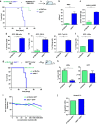Acceleration of Bcr-Abl+ leukemia induced by deletion of JAK2
- PMID: 24791858
- PMCID: PMC4158830
- DOI: 10.1038/leu.2014.152
Acceleration of Bcr-Abl+ leukemia induced by deletion of JAK2
Figures


Similar articles
-
Janus kinase 2 regulates Bcr-Abl signaling in chronic myeloid leukemia.Leukemia. 2011 Mar;25(3):463-72. doi: 10.1038/leu.2010.287. Epub 2010 Dec 24. Leukemia. 2011. PMID: 21183952 Free PMC article.
-
BCR-ABL uncouples canonical JAK2-STAT5 signaling in chronic myeloid leukemia.Nat Chem Biol. 2012 Jan 29;8(3):285-93. doi: 10.1038/nchembio.775. Nat Chem Biol. 2012. PMID: 22286129
-
BCR-ABL but not JAK2 V617F inhibits erythropoiesis through the Ras signal by inducing p21CIP1/WAF1.J Biol Chem. 2010 Oct 8;285(41):31774-82. doi: 10.1074/jbc.M110.118653. Epub 2010 Jul 27. J Biol Chem. 2010. PMID: 20663870 Free PMC article.
-
Concurrent JAK2-Positive Myeloproliferative Disorder and Chronic Myelogenous Leukemia: A Novel Entity? A Case Report With Review of the Literature.J Investig Med High Impact Case Rep. 2019 Jan-Dec;7:2324709619832322. doi: 10.1177/2324709619832322. J Investig Med High Impact Case Rep. 2019. PMID: 30803277 Free PMC article. Review.
-
Hematopoietic stem cells in chronic myeloid leukemia.Arch Med Res. 2003 Nov-Dec;34(6):496-506. doi: 10.1016/j.arcmed.2003.09.005. Arch Med Res. 2003. PMID: 14734089 Review.
Cited by
-
The KRAS-G12D mutation induces metabolic vulnerability in B-cell acute lymphoblastic leukemia.iScience. 2022 Feb 7;25(3):103881. doi: 10.1016/j.isci.2022.103881. eCollection 2022 Mar 18. iScience. 2022. PMID: 35243242 Free PMC article.
-
Inhibition of STAT5: a therapeutic option in BCR-ABL1-driven leukemia.Oncotarget. 2014 Oct 30;5(20):9564-76. doi: 10.18632/oncotarget.2465. Oncotarget. 2014. PMID: 25333255 Free PMC article. Review.
-
JAK2/STAT5 inhibition by nilotinib with ruxolitinib contributes to the elimination of CML CD34+ cells in vitro and in vivo.Blood. 2014 Aug 28;124(9):1492-501. doi: 10.1182/blood-2013-12-545640. Epub 2014 Jun 23. Blood. 2014. PMID: 24957147 Free PMC article.
-
Decreased NK-cell tumour immunosurveillance consequent to JAK inhibition enhances metastasis in breast cancer models.Nat Commun. 2016 Jul 13;7:12258. doi: 10.1038/ncomms12258. Nat Commun. 2016. PMID: 27406745 Free PMC article.
-
Carboplatin-Induced Thrombocytopenia through JAK2 Downregulation, S-Phase Cell Cycle Arrest and Apoptosis in Megakaryocytes.Int J Mol Sci. 2022 Jun 3;23(11):6290. doi: 10.3390/ijms23116290. Int J Mol Sci. 2022. PMID: 35682967 Free PMC article.
References
-
- Harrison C, Kiladjian J-J, Al-Ali HK, Gisslinger H, Waltzman R, Stalbovskaya V, et al. JAK inhibition with ruxolitinib versus best available therapy for myelofibrosis. N Engl J Med. 2012;366:787–798. - PubMed
-
- Harry BL, Eckhardt SG, Jimeno A. JAK2 inhibition for the treatment of hematologic and solid malignancies. Expert Opin Investig Drugs. 2012;21:637–655. - PubMed
Publication types
MeSH terms
Substances
Grants and funding
LinkOut - more resources
Full Text Sources
Other Literature Sources
Medical
Molecular Biology Databases
Miscellaneous

